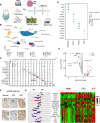Characterizing dedifferentiation of thyroid cancer by integrated analysis
- PMID: 34321197
- PMCID: PMC8318367
- DOI: 10.1126/sciadv.abf3657
Characterizing dedifferentiation of thyroid cancer by integrated analysis
Abstract
Understanding of dedifferentiation, an indicator of poo prognosis for patients with thyroid cancer, has been hampered by imprecise and incomplete characterization of its heterogeneity and its attributes. Using single-cell RNA sequencing, we explored the landscape of thyroid cancer at single-cell resolution with 46,205 cells and delineated its dedifferentiation process and suppressive immune microenvironment. The developmental trajectory indicated that anaplastic thyroid cancer (ATC) cells were derived from a small subset of papillary thyroid cancer (PTC) cells. Moreover, a potential functional role of CREB3L1 on ATC development was revealed by integrated analyses of copy number alteration and transcriptional regulatory network. Multiple genes in differentiation-related pathways (e.g., EMT) were involved as the downstream targets of CREB3L1, increased expression of which can thus predict higher relapse risk of PTC. Collectively, our study provided insights into the heterogeneity and molecular evolution of thyroid cancer and highlighted the potential driver role of CREB3L1 in its dedifferentiation process.
Copyright © 2021 The Authors, some rights reserved; exclusive licensee American Association for the Advancement of Science. No claim to original U.S. Government Works. Distributed under a Creative Commons Attribution NonCommercial License 4.0 (CC BY-NC).
Figures





References
-
- Siegel R. L., Miller K. D., Jemal A., Cancer statistics, 2019. CA Cancer J. Clin. 69, 7–34 (2019). - PubMed
-
- Knauf J. A., Ma X., Smith E. P., Zhang L., Mitsutake N., Liao X. H., Refetoff S., Nikiforov Y. E., Fagin J. A., Targeted expression of BRAFV600E in thyroid cells of transgenic mice results in papillary thyroid cancers that undergo dedifferentiation. Cancer Res. 65, 4238–4245 (2005). - PubMed
-
- Molinaro E., Romei C., Biagini A., Sabini E., Agate L., Mazzeo S., Materazzi G., Sellari-Franceschini S., Ribechini A., Torregrossa L., Basolo F., Vitti P., Elisei R., Anaplastic thyroid carcinoma: From clinicopathology to genetics and advanced therapies. Nat. Rev. Endocrinol. 13, 644–660 (2017). - PubMed
-
- Boumahdi S., de Sauvage F. J., The great escape: Tumour cell plasticity in resistance to targeted therapy. Nat. Rev. Drug Discov. 19, 39–56 (2020). - PubMed
LinkOut - more resources
Full Text Sources
Other Literature Sources
Research Materials

